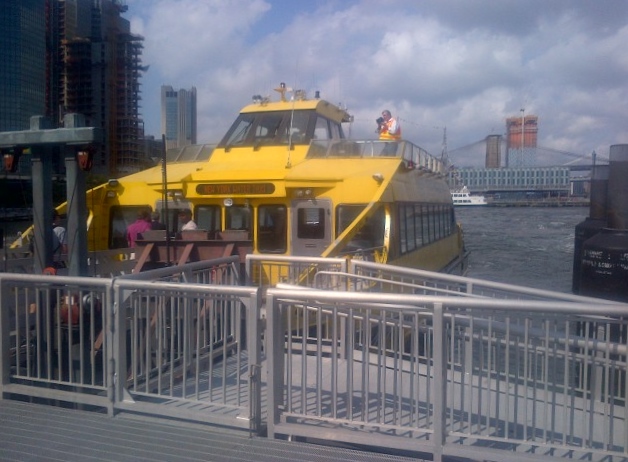The summer of 2017 will be not-so-fondly remembered as the "summer of hell”, as dubbed by New York Gov. Andrew Cuomo, for railway commuters into midtown Manhattan’s Penn Station, one of the city’s major transit hubs.
Passengers traveling from both the west (New Jersey) and the east (Long Island) have been disrupted by emergency repairs at Penn by Amtrak, which was forced into action after multiple derailments at Penn Station. A significant number of rush hour trains have been cancelled because of the work, which began July 7. Work is now on pace to be completed by Sept. 1, the agency said.
Desperate times call for innovative measures. On the New York side, the emergency “Plan B” for the Long Island Rail Road includes numerous charter buses, but also an improvised set of ferry runs, linking residential Glen Cove on the North Shore of Long Island, with Manhattan. During the emergency, LIRR ticket holders can ride the ferry for free.
Wall Street and downtown, with a ferry terminal at Pier 11, is served by an early morning trip in, with a late afternoon departure at 4:30 p.m. Midtown at the 34th East River ferry landing is also served by an early morning inbound run, with the return trip departing 34th Street at 6:20pm.
Truth be told, my commuting pattern has seen minimal hellishness since I’d hacked various ways to avoid Penn Station long before the onset of the current woes. On the days of my ferry adventures, I’ve taken trains inbound at the tail end of the morning rush hour, and experimented in the afternoon with boat rides eastward.
From Wall Street, I rode on the Incat Crowther-designed 149-passenger catamaran Seymour R. Durst. Built in 2002 by Gladding-Hearn Shipbuilding, Duclos Corp., the vessel is part of New York Water Taxi, recently acquired by New York Cruise Lines LLC.
From Midtown later the same week, I traveled aboard the 225-passenger Patriot II, built in 2003 by Yank Marine, and on loan for the Glen Cove-Manhattan route from Washington, D.C.-based National Ferry Corporation.
These are not luxury vessels. Their utilitarian layouts happily include ample outside seating and standing areas. Indeed, for tugboat watchers, the outdoor scenery was as good as it gets, riding up the East River through the Hell Gate under the Whitestone and Throgs Neck bridges, and out into western Long Island Sound. In the peak-of-summer July heat, with the storms holding off until later at night, the lack of beverage service (beyond water), Wi-Fi and comfortable seats, along with a minimal complement of hard to reach electrical outlets, was certainly not a deal-breaker, at least for me. Stepping inside, air conditioning was more than ample.

The tug Nathan near Glen Cove, N.Y. Barry Parker photo.
My issues with these ferries are very much on the landside. Yes, this summer run is an emergency response to train trouble. But the city of Glen Cove (having built a $7 million ferry terminal at the site of a future mega real estate development, maybe) has longer term designs for ferry service. This fall, it will be issuing another request for proposals to ferry operators who might want to launch a regular Glen Cove run.
Local ferry supporters view this summer’s adventures as a launching ramp for long-term plans. I would not hold my breath, however, but we’ll save that for another article.
Most of the folks that I spoke to characterized this summer’s schedule with words that included “joke” and unprintable epithets. The extreme non-coordination with landside transportation would embarrass even first week students in a logistics 101 class, compared to New York Waterway’s ubiquitous network of well-scheduled bus interfaces, where riders can hop off the boat and onto a waiting bus.
In Midtown, chatting online prior to departure, I met one gent whose residence was within a half mile of the Glen Cove terminal, and who works at one of the hospitals near the East 34th Street terminal. He’s the logistical exception. Proximity breeds ridership and he told me he’d taken the ferry daily since its July 10 start.
However, a veteran Wall Street friend who rode east with me on the downtown run reminded me that floor traders who could leave their posts at 4 p.m. when the New York Stock Exchange closes and can make a 4:30 p.m. departure, were a remnant of a bygone era.
On both of my trips, in hot weather that is ideal for a boat ride, I estimated the passenger count at around 40 people.  During the winter months — when riders would likely pay a not unsubstantial fare, with howling winds and possible ice floes that would force the boats to slow down from their approximately 20-knot speeds — how many riders would a ferry attract given the same lack of logistics?
Perhaps a few inveterate maritime junkies might endure the journey. But that’s about it.




